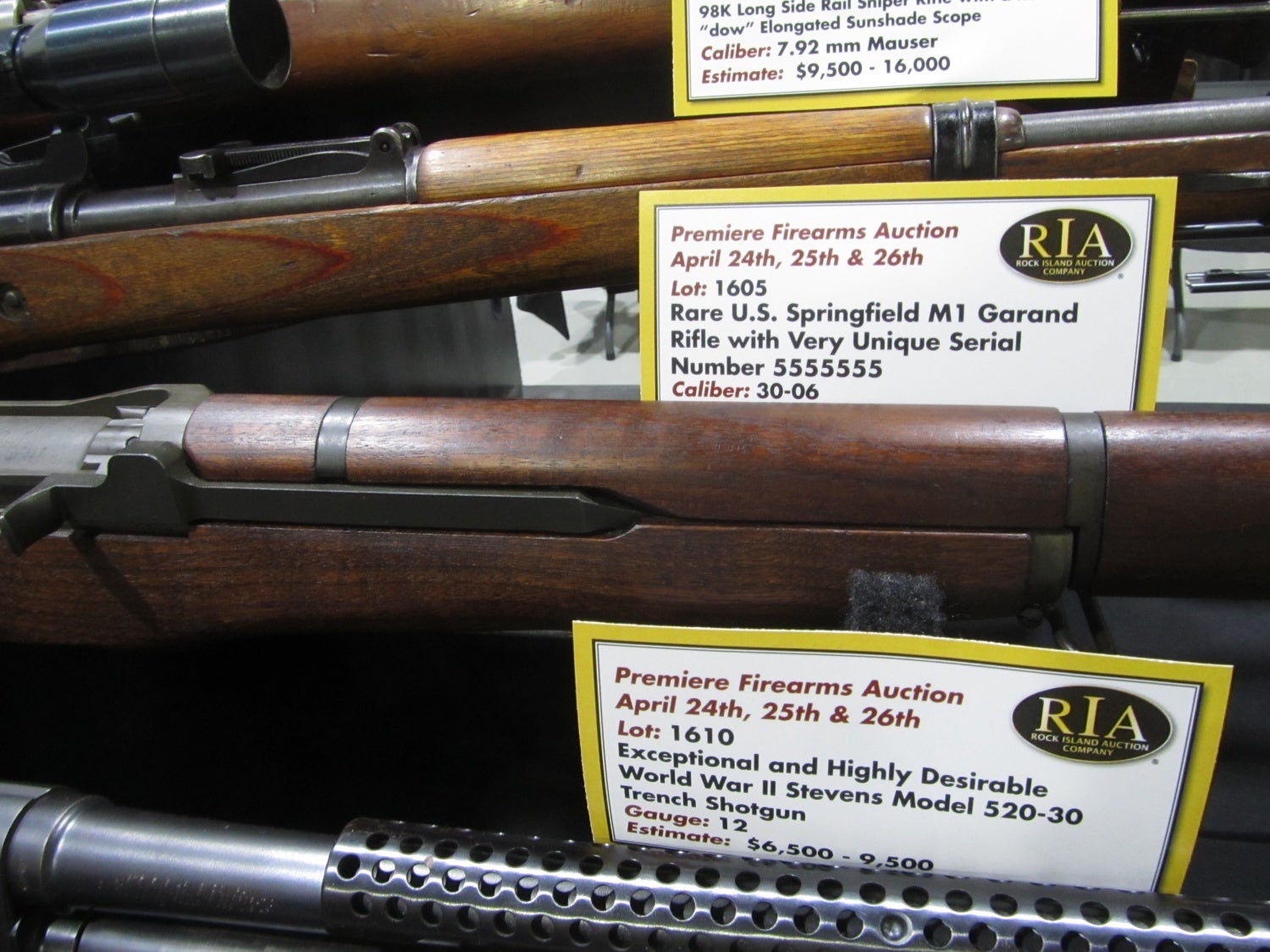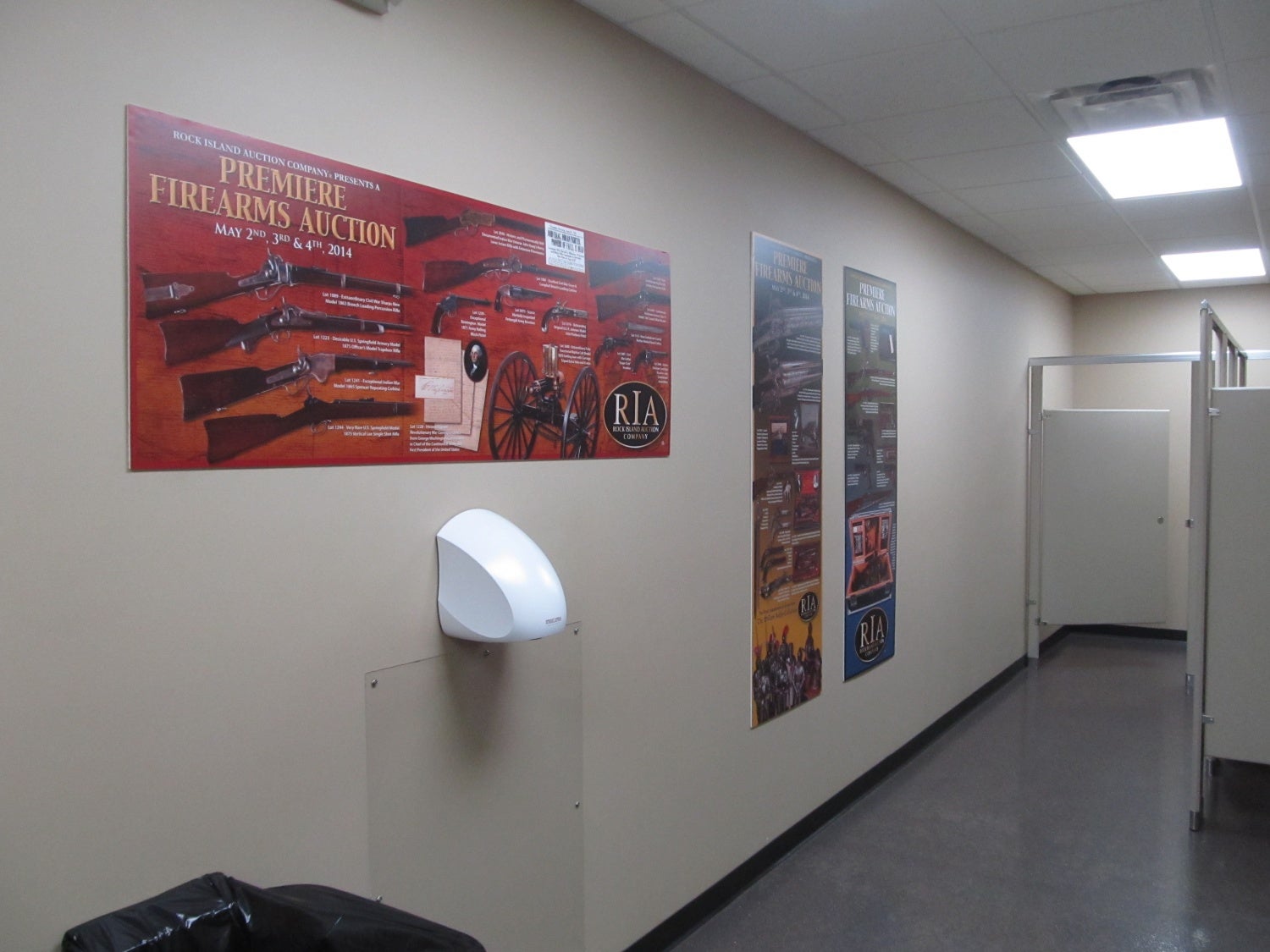Rock Island Auction company has slowly but steadily gained an overwhelming presence in the shooting industry since the company’s start in the 1990s. For their most recent premiere auction, TFB went to check them out and see what we could find out about the company and what makes them so effective at auctioning small arms. We’re not so interested in the content, Ian from Forgotten Weapons does a great enough job at that already, as we are in how exactly the auction works.
History
The company began when the owner, Patrick Hogan began producing high end catalogs for two other auction companies in the photography business. In 1993, he came to the conclusion that not only could he be working with firearms, but he could be doing it on his own as well. Thus he began Rock Island Auction Company. In 2011, RIAC expanded and moved into their current facility, a former Coca-Cola distribution center, after a near-total renovation. One of the principle reasons behind RIA’s success is the complete emphasis on presentation. RIAC prides itself on their motto of “We believe in Presentation.” This presentation begins the second incoming firearms show up in the warehouse where they have their descriptions written, are photographed extensively, and entered into the catalog. Then graphic design takes over and creates the elaborate pages seen in the catalogs and publications everywhere.

I was told that some miniature gun makers, use miniature tools to make miniature firearms, to mimic the actual tool marks found on their true scale counter parts (so they have miniature tool marks as well). I couldn’t get the idea of miniature hammers and miniature drills out of my head for the rest of the day…

This Lemat revolver has a traditional cap and ball cylinder and barrel. But underneath that, there is a shotgun barrel and the nipple for that in that center piece. With a flick of the hammer, either can be chosen to fire.
Auctions
RIAC has two main auctions: Regional and Premiere. Each year there are three Premiere Auctions and two Regional Auctions. The Regionals have beginner-grade collector arms, thousands of usable and modern arms, in addition to stuff that firearms enthusiasts often find interesting: ammunition, books, Western art, knives, and lots of military items. Premiere Auctions, on the other hand, generally hold ultra-high condition, historic, rare, and extremely valuable firearms. Both auctions routinely last 3 days or say, starting on a Friday and continuing until Sunday with prior Thursday as the Preview Day. This process is the foundation for the company and thus the company dedicates a staff of employees for each step to ensure everything goes smoothly and everything is cross checked. Even with this double-check errors still come out, but RIAC produces a corrections sheet prior to auction. It is included in their weekly email, available on their website, and even handed out at the beginning of each auction day.
This is a video from one specific rifle that went on auction in 2012. RIA will go literally go through thousands of such exchanges throughout the course of an auction.
The Facility
The auction lobby is the very first room that visitors enter. This is where bidders will register with RIAC, get their appropriate paperwork for bidding, and grab a free-will donation meal (all donations are matched and given to an organization of RIAC’s choice).
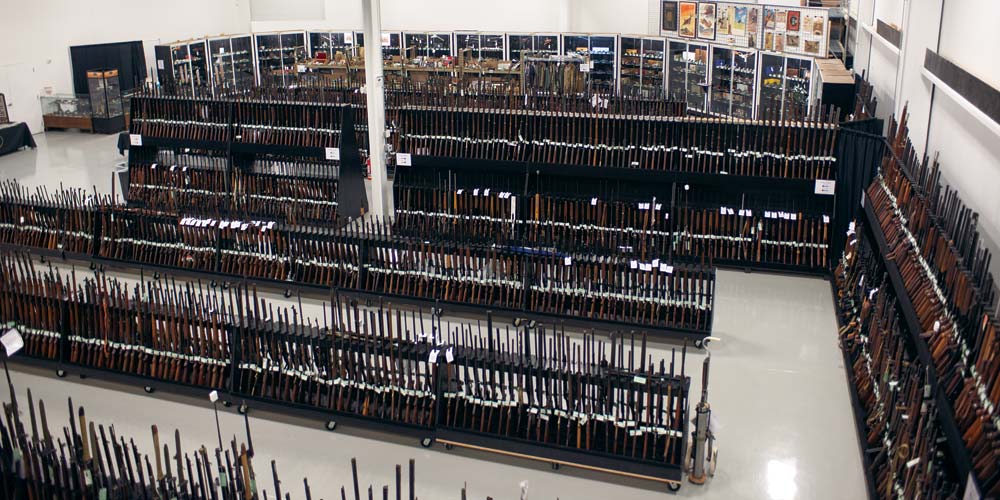
A great shot covering most of half of the Preview Hall, the other half continues on to the far left. Source- RIA
The preview hall is located through a back hallway behind the auction hall. It encompasses the majority of the building, forming an “L” shape around the auction hall. This is where most of the firearms/militaria that are being auctioned are displayed in glass cases or on cloth covered racks all around the walls. The preview hall opens up each day before the auction begins, so participants can walk in and evaluate the items they are interested in up close and in person. The hall is organized into three sections that match to the days of the auction. As an auction day begins, the corresponding section of firearms is closed off to the public with black cloth. The general rules are that they can handle anything and work the actions, but cannot dry fire or disassemble any firearms. Employees posted around the preview hall serve as customer service liaisons as well as help to keep watch over all the items. The preview hall allows bidders to really investigate what they are buying, as they’ll be spending thousands of dollars on just a single firearm at times.
After finishing in the preview hall, potential bidders make their way to the auction hall. That’s where all the action takes place, and where bidders will sit throughout the day and place bids by holding up their registered bidding cards. They would have also had the opportunity to absentee bid prior to that day’s auction via telephone or the RIAC webpage. The whole process is video recorded, so any potential errors can be resolved quickly and accurately. To the side of the live audience is a bank of around 40 RIAC employees assisting live telephone bidders. Next to the phone bidders, and closest to the auctioneer’s podium, are employees with laptops open in front of them, taking live internet bids. The auctioneers sit at the front of room behind their large wooden podium. They work in 25 lot “shifts” to reduce stress and to allow each auctioneer some time to refresh. Behind them is a large projection screen with pictures and a short description of the item being auctioned. In addition to this screen, there are multiple large screen TVs throughout the auction hall and auction lobby so patrons can see what is currently being sold at any time.
A Youtube tour of Ian from Forgotten Weapons at RIA.
“Where do all these firearms come from?”
Firearms at RIAC come from many different sources. Some come by way of collectors selling a few pieces so they can in turn buy something they want even more. Others are from collectors finally selling their guns to serve as their “retirement fund.” Finally, many come to RIAC as estate collections from deceased collectors. While these account for large groups of firearms that arrive, thousands more are single item consignments from individual collectors. Collections can be sold in several multi-gun lots or by individual firearm. When a collection is sold in separate multi-gun “lots,” that means a buyer will pay one price for all the guns within that lot. Bidders also aren’t just individual collectors but sometimes represent dealers who are looking for various lots of firearms that they can add to their stores.
The Competition
Although there are a number of auction houses today that work with collectible firearms, most don’t come close to the sheer numbers that RIAC produces. As an example, here are the price figures from RIA as quoted from their website:
2004: $14.6 million
2005: $16 million
2006: $19 million
2007: $28.6 million
2008: over $31 million
2009: $28 million
2010: $32 million (industry record)
2011: $32 million
2012: $47 million (another industry record)
2013: $48 million
2014: $47.5 million
As compared to James D. Julia’s figures for a similar period:
2002-2010- All auctions are below $ 12 million
March 2011: $10 million
October 2011: $ 9 million
March 2012: $18 million
October 2012: $16.5 million
March 2013: $13.5 million
October 2013: $18 million
March 2014: $19 million
October 2014: $19.3 million
James Julia typically focusses on high end firearms, while RIAC in addition to auctioning high end firearms (a Colt Paterson sold for $414,000 the weekend I was visiting), sells thousands of usable and modern firearms as well.

The warehouse in the back of the RIA building. This is where all the nitty gritty work of receiving, photographing, storing, cataloging, and moving firearms takes place. Surprisingly a certain amount of firearms actually come to the building loaded, so due caution is always taken.
Preview hall
The Preview hall is located through a back hallway behind the auction hall. It encompasses the majority of the building, forming an “L” shape around the auction hall. This is where most of the firearms/militaria that are being auctioned are displayed on cloth covered racks all around the walls and the floor of the Preview hall. The hall opens up the day before any auction begins, so auction participants can walk in and evaluate the items they are interested in up close and in person. The general rules are that they can handle anything and work the actions, but cannot dry fire or disassemble any firearms. Security is extremely tight here as people have been caught trying to sneak out of the Preview hall with handguns and other smaller pieces of equipment. Cameras and watchful employees (placed all around the hall) ensure that things like this don’t happen, or at least try to keep it from happening.

An example of one corner of the Preview hall. Table on the left is the Class Three section, handguns are in the glass cases on the right, uniforms in the corner, while various rifles are laid up against the rear walls. The people with black shirts on are RIA employees, making sure nothing is damaged or stolen.
The hall is organized into three sections that match to the days of the auction. As an auction takes place, the corresponding section of firearms is closed off to the public with black cloth. As firearms are won, RIA employees are quick to pick them out, package them up and begin the shipping process. Or they can be picked up after the auction is over as well by their corresponding winners in person, if legally permitted. Also, the Preview hall allows bidders to really investigate what they are buying, as they’ll be spending thousands of dollars on just single firearms at times. It isn’t like the firearm will come up in the auction and they’ll have an impulse to buy it just from the screen shots they see of it.

The front entrance as you walk into RIA. The catalogs are only made for the Premiere Auctions, but they indeed glorious.
Front Entrance
The very first room that visitors enter is the registration hall. This is where bidders will register with RIA, get their appropriate paperwork for bidding and go through a NICs check so they can legally purchase firearms. RIA has an assortment of procedures set in place to accommodate buyers interested in Class Three items . Beyond the registration there is a large room full of tables to sit at and free donuts!
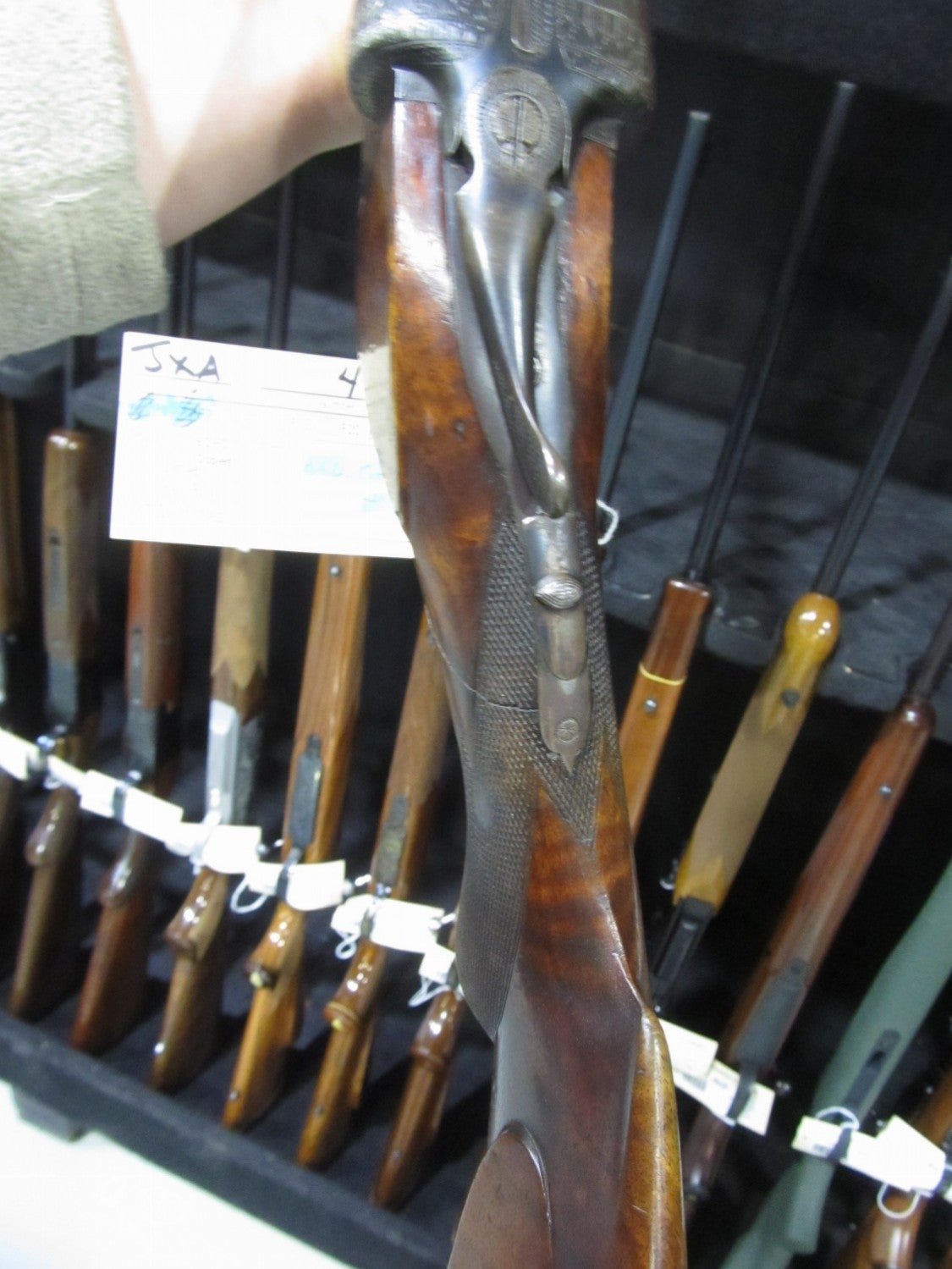
The shotgun was designed to accommodate shooters with left eye dominance but who were right handed. Unfortunately it wasn’t designed to accommodate the laws of Physics, which include recoil.
Working with the auction firearms
As I talked with the various employees from RIA, I pointed out that dealing with this amount of firearms would probably make a person sick of them entirely, similar to the point I made in a previous post about working in an armory, where firearms could eventually become pieces of material to be fretted over instead of really liking the work. One of the description writers for RIAC (who was extremely kind in talking me through the process and showing me around the Preview Hall) agree with a caveat. He admitted that, yes, it does get tedious with some of the common place firearms, but the real perks of the job are when the crazy and interesting things come through like item with odd histories, guns with rare features, collectibles with ties to people from history, and experimental prototypes.
Of course, as with any auction house, there are going to be items that cannot be authenticated. What happens with those? Many times RIAC will sell the item, while fully disclosing the questionable provenance. Usually in both the headline and the description they’ll flat out say that the item has an “alleged” story or that the item is “claimed” to be something. Any documentation that a consignor provides to make their argument for their item is always included.
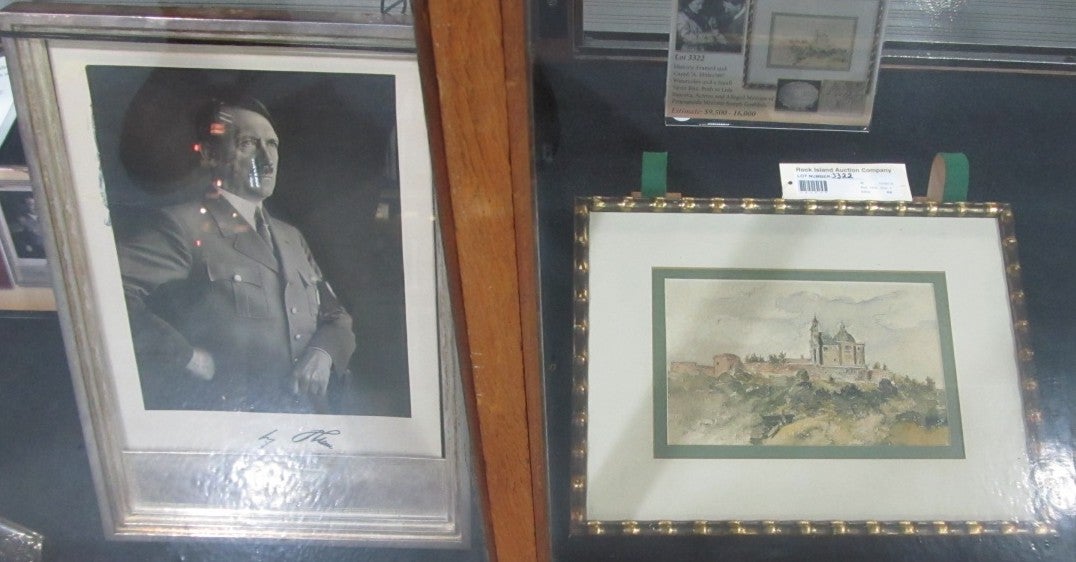
One of the more interesting items on auction is an original painting by the Fuhrer himself. Interestingly enough RIA is constantly getting a large amount of Nazi war memorabilia, including not pictured is an encased copy of Mein Kempf. The picture on the right is also allegedly signed by Hitler.
Presentation Aspect
One of the principle reasons behind RIA’s success is the complete emphasis on presentation. RIA prides itself on their motto of “We believe in Presentation”. How they do this is through a crew of professional photographers that know their stuff when it comes to arranging firearms for the cameras, and graphic artists working with photo editing software, to creating the charts and sheets that are featured throughout the building and outside RIA in the advertising world. This presentation begins the second incoming firearms show up in the warehouse where they have their descriptions written, are photographed extensively, and entered into the catalog. Then graphic design takes over and creates the elaborate pages seen in the catalogs and publications everywhere. This process is the foundation for the company and thus the company dedicates a staff of employees for each step to ensure everything goes smoothly and everything is cross checked. And even so, errors do come out, pointed out by RIA staff later on, and by auction participants during the auction. In that case, the company comes out with an error sheet before the auctions that show maybe a description, serial number or name was off in some fashion.
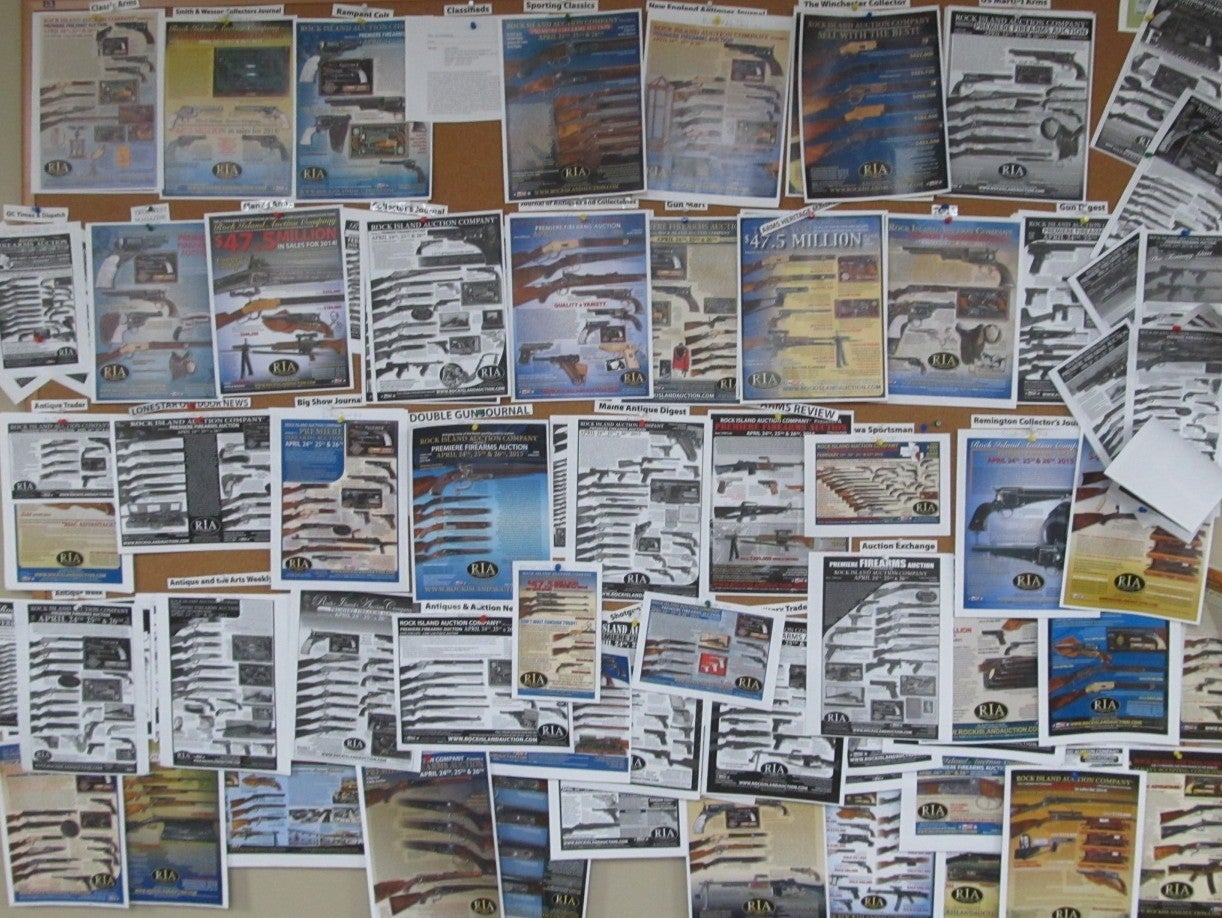
This is the advertisement board in the back offices of the company, showing the various publications that RIA uses to get their auction information out.

An example of how each advertisement is tailored specifically to each magazine or publication it is featured in.
A video from RIA at NRA annual Meetings.
TFB would like to express an extreme amount of gratitude towards Joel Kolander, the RIA public relations manager and blog writer. Without his patience and superb tour of the facility, the depth of knowledge in this post would not have been possible.
 Your Privacy Choices
Your Privacy Choices




